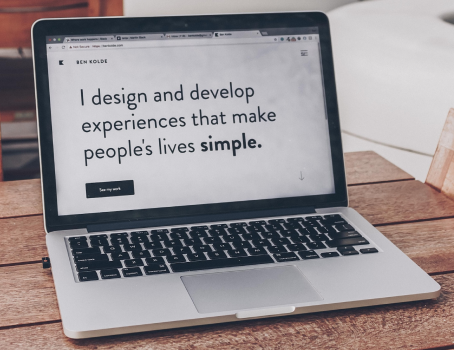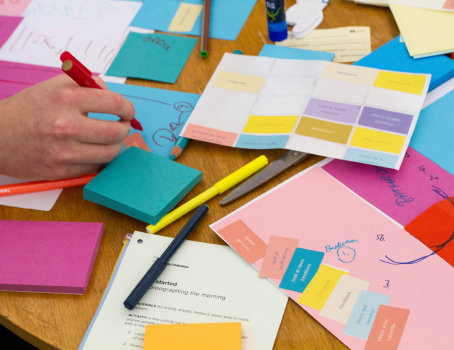
Tips and Tricks for a Beginner- UI UX Design
January 23, 2023
January 23, 2023
Tell us about your project right here, or send us an email at hello@penonpaper.in

“Design thinking is a human-centered approach to innovation
that draws from the designer's toolkit to integrate the
needs of people, the possibilities of technology, and the
requirements for business success.”
- Tim Brown, CEO IDEO
Design thinking is a new way of thinking that helps you
solve problems and create products. It's a process that
helps you break down a problem or challenge into its
individual parts and then design solutions for those parts.
By doing this, you can come up with innovative ideas and
solutions that are better than those that you would have
come up with on your own. In this blog post, we'll walk you
through the steps of the design thinking process, and
explain why it's so important. We'll also introduce you to
some of the most commonly used tools and techniques in
design thinking, so that you can start applying it to your
own projects right away!
We are living in a time when people are seeking fresh and
efficient ways to seek education, run their businesses, be
social, and provide value to the world.
We are fortunate to have access to tools and technology that
provide us with the opportunity to explore new and
innovative ways to learn, teach, and innovate.
Design thinking is a popular process that helps business and
organizations develop solutions to problems by involving all
members of the team.design Thinking starts with an
understanding of the problem, followed by exploration,
creation, testing and implementation. It can be used in many
different fields, such as marketing, product development,
engineering and management. What are some benefits of using
design thinking?
Some benefits include:
- Improved creativity and innovation due to faster
turnaround times;
- More effective communication due
to everyone being involved from early on in the process;
- Greater flexibility due to continuous adaptability;
- Increased efficiency since ideas are tested quickly before
they're implemented.

How to adapt the design process to your needs:
Design thinking is a powerful process that can be adapted
to different stages of a startup. It helps solve problems
and create new solutions, which in turn leads to better
products or services. By following the steps below, you
will get a better understanding of how it works and
improve your product design skills.
The first step is to explore - this involves generating
ideas and coming up with concepts that may not have been
considered before. Next comes problem solving - where you
figure out ways to make these ideas work practically. This
stage often includes creating prototypes - visual
representations of what the final product might look like.
The next step is testing - which Evaluates the prototype
for whether it achieves its objectives or not. Finally,
delivery follows where you put the idea into practice and
make it available for others to try out!
What are the 5 Stages of the Design Thinking Process
Design Thinking is a process that can be extremely beneficial to startups. It helps to identify and solve problems by using creative thinking. The five stages of the process are ideation, experimentation, design, delivery, and evaluation. Ideation involves generating ideas and concepts, experimentation involves testing these ideas, design involves making the final decisions on how to solve the problem, delivery entails creating and implementing the solution, and evaluation involves ensuring that the product or service meets both functional and aesthetic needs. By following these stages, startups can develop better solutions and make better decisions.
Stage 1: Empathize—Research Your Users' Needs
In order to create a successful content marketing strategy, it is important to empathize with your users and understand their needs. By doing so, you will be able to come up with innovative ideas that would meet their needs and provide the desired results. user research helps in understanding what your users want and how you can help them get it. It also allows for creativity as you think of ways in which you could bring about change or improve upon existing solutions. Furthermore, make sure that the design is easy on the eyes - even for those who are not tech-savvy!
Stage 2: Define—State Your Users' Needs and Problems
In stage 2 of your content marketing strategy, you need to define your users and their needs. You will also need to understand the problems they are facing. Use this data to find a solution that is tailor-made for them. Be creative when coming up with ideas to solve user problems! This might include developing new products or services, creating awareness campaigns, or even designing custom solutions specific to your target audience's needs. All these efforts will help you achieve better results in terms of engagement and conversion rates!
Stage 3: Ideate—Challenge Assumptions and Create Ideas
The third stage of the design thinking process is ideate - where you come up with new ideas. In order to do this, you need to challenge your assumptions and look for ways in which your idea can be implemented. This might involve brainstorming, sketching or even writing down your thoughts. Once you have a few potential ideas, it's time to test them out and see which one works best for your startup!
Stage 4: Prototype—Start to Create Solutions
In stage 4, you start to create solutions by creating a prototype. This could be anything from a rough sketch to a fully functioning product. You need to test it and see how users react before moving on to the next stage of the process. The three main stages in this phase are ideation, prototyping, and testing.
Stage 5: Test—Try Your Solutions Out
In stage 5, you will test your solutions to see if they are successful. You will need to be creative and think outside the box when it comes to testing your ideas. However, it is important to document your process so you can track your progress and improvements over time

Conclusion:
There is no one-size-fits-all solution to design thinking - it depends on the problem or challenge that you are facing as a startup. However, following these essential steps will help you move closer towards solving it: Start by coming up with a problem or challenge that your business faces. Once you have identified this, start sketching and prototyping different ideas based on what you have observed. You need to test them out so that you can get feedback and identify which ones work best. Remember, design thinking isn't about being perfect - it's about getting closer to the solution. Be open to feedback at all stages of the process so that your idea becomes better and better over time. Constantly evaluate how far along you are in reaching your goal while incorporating new insights into future iterations of your concept(s). And always remember, design thinking is not static; it should be adaptable and evolve alongside ever changing changes in industry conditions.
If you are new to the world of startups, or simply looking to up your game, Design Thinking is the perfect tool for you. This process helps you create innovative solutions to problems by engaging with users and stakeholders early in the design process. In this blog post, we have outlined the steps involved in the design thinking process, as well as provided resources to help you get started. So, whether you are a startup founder or just looking to be more effective when working with design teams, read on!.

January 23, 2023

January 23, 2023